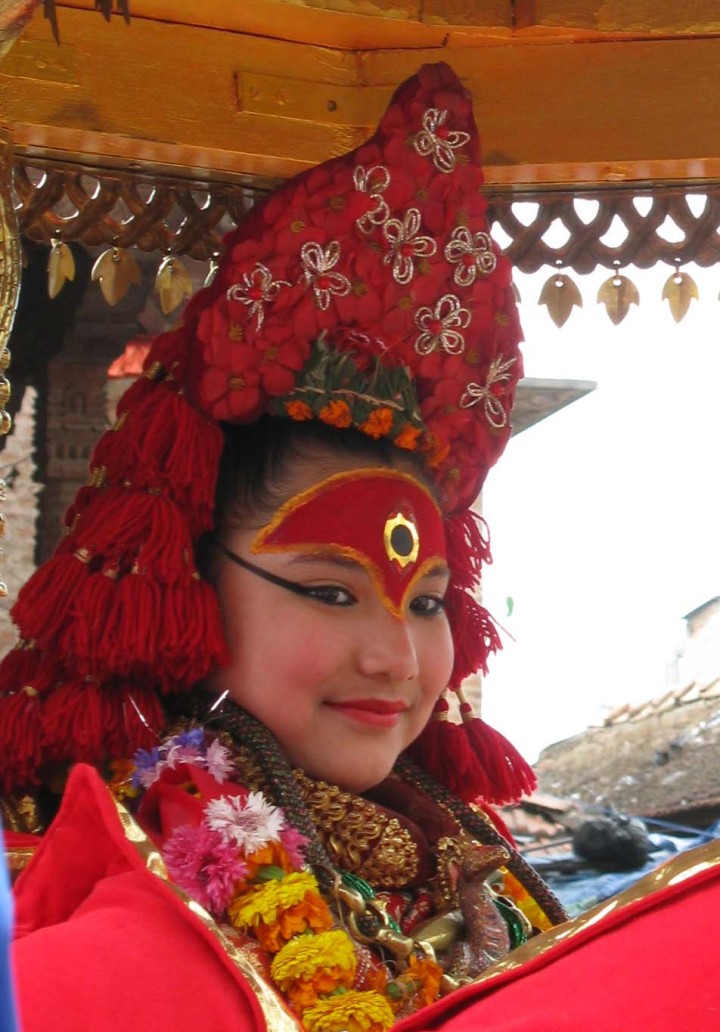Kumari – Living Goddess of Nepal
The Kumari is a young girl who is believed to be the incarnation of the demon-slaying Hindu goddess Durga. Dating back at least to the Middle Ages, the cult of the Kumari is popular among both Hindus and Nepalese Buddhists – another notable example of the mingling of religious traditions in Nepal. There are about 11 kumaris across Nepal, but the Kumari Devi (or Raj Kumari – royal goddess) in Kathmandu is the most important.

The selection process for finding the Kumari Devi resembles that of the Tibetan lamas, who are believed to be reincarnations of their predecessors. She is chosen from girls aged three to five in the Buddhist Shakya clan. Elders meet with hundreds of girls, approving only those with 32 auspicious signs of divinity (mostly to do with natural perfection and symbolically significant features). The girls’ horoscopes are also checked to ensure they are compatible with those of the current king.
The small group of would-be goddesses are then placed in a darkened room with freshly severed buffalo heads and dancing men wearing demon masks. This is certainly frightening to ordinary girls under five years old, but the goddess would not be frightened. Therefore the girl who shows no fear is likely to be the incarnation of Durga. In one final test, the girl must be able to pick out the clothing of her predecessor.
Thus discovered, the Kumari moves into the Kumari Ghar and is worshipped as a living goddess. Her needs and those of her caretakers are paid in full by the Nepalese government and she spends most of her time studying and performing religious rituals. She only leaves the temple a few times a year during festivals and her feet must never touch the ground.
The Kumari’s reign comes to an end when she menstruates or bleeds for any other reason, including just a minor scratch. The girl reverts to mortal status and the search for her replacement begins. She is given a modest state pension, but may find it difficult to marry – tradition has it that a man who marries an ex-Kumari will die young.
Festivals and Events
The most important festival for the Kumari is Indra Jaatra, a celebration of the harvest held in late August or early September. On the third day of the festival, the Kumari Devi is carried around Durbar Square in a chariot. The chariot is kept next door to the Kumari Ghar and the great wooden yokes from past years are laid out nearby.
In a tradition established by King Jaya Prakash Malla (builder of the temple), the Kumari also bestows a tika (mark of blessing) on the forehead of the king who would reign in the coming year. This tradition was used against the king within a year: he was driven into exile on the even of Indra Jaatra in 1768, allowing the conqueror to take the tika and become the rightful king.
DISCLAIMER
Please note that this site has been created for providing information regarding your trip to Nepal, Tibet, Bhutan, India and other countries.
Images contained in static.muskcdn.com have been obtained from various free internet sources. The copyright of these pictures and texts belongs to their original publisher / photographer. Please let me know at anil.blon@gmail.com if any Copyright Violation occurs and we will remove them right away.
If by anyhow any of the content is offensive to you, please, contact us asking for the removal. If you own copyrights over any of them and do not agree with it being shown here, please send us an email and we will remove it. email us at –anil.blon@gmail.com
Or you can call me at 00977 9851024915

